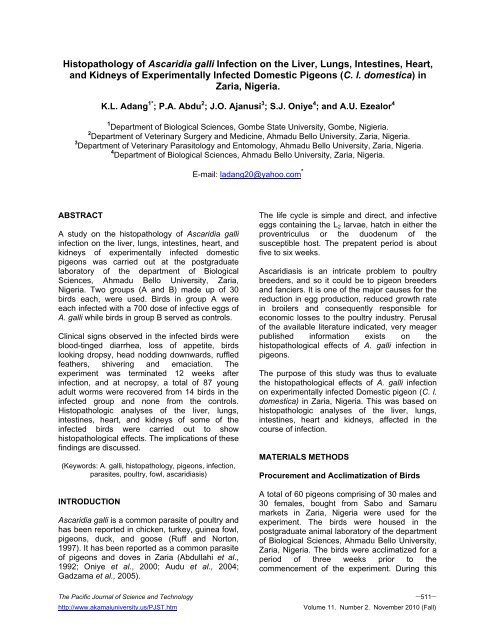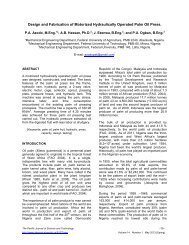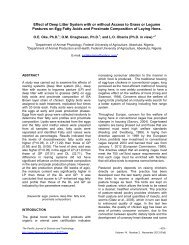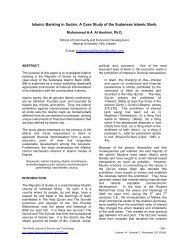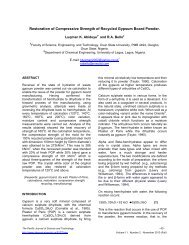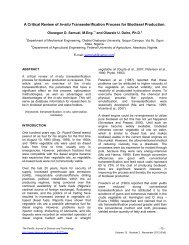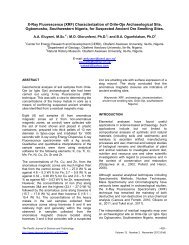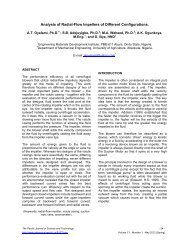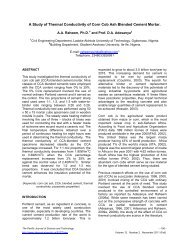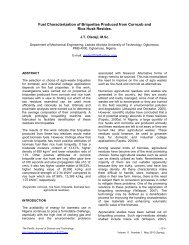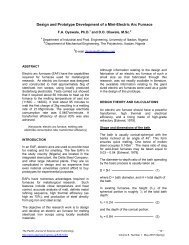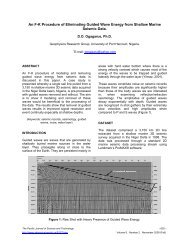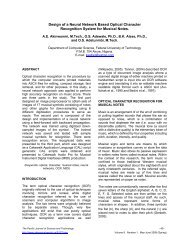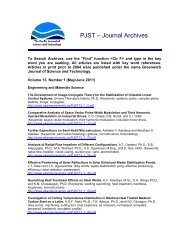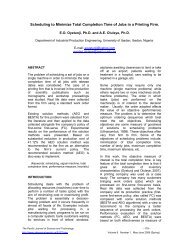Histopathology of Ascaridia galli Infection on the Liver, Lungs ...
Histopathology of Ascaridia galli Infection on the Liver, Lungs ...
Histopathology of Ascaridia galli Infection on the Liver, Lungs ...
You also want an ePaper? Increase the reach of your titles
YUMPU automatically turns print PDFs into web optimized ePapers that Google loves.
<str<strong>on</strong>g>Histopathology</str<strong>on</strong>g> <str<strong>on</strong>g>of</str<strong>on</strong>g> <str<strong>on</strong>g>Ascaridia</str<strong>on</strong>g> <str<strong>on</strong>g>galli</str<strong>on</strong>g> <str<strong>on</strong>g>Infecti<strong>on</strong></str<strong>on</strong>g> <strong>on</strong> <strong>the</strong> <strong>Liver</strong>, <strong>Lungs</strong>, Intestines, Heart,<br />
and Kidneys <str<strong>on</strong>g>of</str<strong>on</strong>g> Experimentally Infected Domestic Pige<strong>on</strong>s (C. l. domestica) in<br />
Zaria, Nigeria.<br />
K.L. Adang 1* ; P.A. Abdu 2 ; J.O. Ajanusi 3 ; S.J. Oniye 4 ; and A.U. Ezealor 4<br />
1 Department <str<strong>on</strong>g>of</str<strong>on</strong>g> Biological Sciences, Gombe State University, Gombe, Nigieria.<br />
2 Department <str<strong>on</strong>g>of</str<strong>on</strong>g> Veterinary Surgery and Medicine, Ahmadu Bello University, Zaria, Nigeria.<br />
3 Department <str<strong>on</strong>g>of</str<strong>on</strong>g> Veterinary Parasitology and Entomology, Ahmadu Bello University, Zaria, Nigeria.<br />
4 Department <str<strong>on</strong>g>of</str<strong>on</strong>g> Biological Sciences, Ahmadu Bello University, Zaria, Nigeria.<br />
ABSTRACT<br />
A study <strong>on</strong> <strong>the</strong> histopathology <str<strong>on</strong>g>of</str<strong>on</strong>g> <str<strong>on</strong>g>Ascaridia</str<strong>on</strong>g> <str<strong>on</strong>g>galli</str<strong>on</strong>g><br />
infecti<strong>on</strong> <strong>on</strong> <strong>the</strong> liver, lungs, intestines, heart, and<br />
kidneys <str<strong>on</strong>g>of</str<strong>on</strong>g> experimentally infected domestic<br />
pige<strong>on</strong>s was carried out at <strong>the</strong> postgraduate<br />
laboratory <str<strong>on</strong>g>of</str<strong>on</strong>g> <strong>the</strong> department <str<strong>on</strong>g>of</str<strong>on</strong>g> Biological<br />
Sciences, Ahmadu Bello University, Zaria,<br />
Nigeria. Two groups (A and B) made up <str<strong>on</strong>g>of</str<strong>on</strong>g> 30<br />
birds each, were used. Birds in group A were<br />
each infected with a 700 dose <str<strong>on</strong>g>of</str<strong>on</strong>g> infective eggs <str<strong>on</strong>g>of</str<strong>on</strong>g><br />
A. <str<strong>on</strong>g>galli</str<strong>on</strong>g> while birds in group B served as c<strong>on</strong>trols.<br />
Clinical signs observed in <strong>the</strong> infected birds were<br />
blood-tinged diarrhea, loss <str<strong>on</strong>g>of</str<strong>on</strong>g> appetite, birds<br />
looking dropsy, head nodding downwards, ruffled<br />
fea<strong>the</strong>rs, shivering and emaciati<strong>on</strong>. The<br />
experiment was terminated 12 weeks after<br />
infecti<strong>on</strong>, and at necropsy, a total <str<strong>on</strong>g>of</str<strong>on</strong>g> 87 young<br />
adult worms were recovered from 14 birds in <strong>the</strong><br />
infected group and n<strong>on</strong>e from <strong>the</strong> c<strong>on</strong>trols.<br />
Histopathologic analyses <str<strong>on</strong>g>of</str<strong>on</strong>g> <strong>the</strong> liver, lungs,<br />
intestines, heart, and kidneys <str<strong>on</strong>g>of</str<strong>on</strong>g> some <str<strong>on</strong>g>of</str<strong>on</strong>g> <strong>the</strong><br />
infected birds were carried out to show<br />
histopathological effects. The implicati<strong>on</strong>s <str<strong>on</strong>g>of</str<strong>on</strong>g> <strong>the</strong>se<br />
findings are discussed.<br />
(Keywords: A. <str<strong>on</strong>g>galli</str<strong>on</strong>g>, histopathology, pige<strong>on</strong>s, infecti<strong>on</strong>,<br />
parasites, poultry, fowl, ascaridiasis)<br />
INTRODUCTION<br />
<str<strong>on</strong>g>Ascaridia</str<strong>on</strong>g> <str<strong>on</strong>g>galli</str<strong>on</strong>g> is a comm<strong>on</strong> parasite <str<strong>on</strong>g>of</str<strong>on</strong>g> poultry and<br />
has been reported in chicken, turkey, guinea fowl,<br />
pige<strong>on</strong>s, duck, and goose (Ruff and Nort<strong>on</strong>,<br />
1997). It has been reported as a comm<strong>on</strong> parasite<br />
<str<strong>on</strong>g>of</str<strong>on</strong>g> pige<strong>on</strong>s and doves in Zaria (Abdullahi et al.,<br />
1992; Oniye et al., 2000; Audu et al., 2004;<br />
Gadzama et al., 2005).<br />
E-mail: ladang20@yahoo.com *<br />
The life cycle is simple and direct, and infective<br />
eggs c<strong>on</strong>taining <strong>the</strong> L2 larvae, hatch in ei<strong>the</strong>r <strong>the</strong><br />
proventriculus or <strong>the</strong> duodenum <str<strong>on</strong>g>of</str<strong>on</strong>g> <strong>the</strong><br />
susceptible host. The prepatent period is about<br />
five to six weeks.<br />
<str<strong>on</strong>g>Ascaridia</str<strong>on</strong>g>sis is an intricate problem to poultry<br />
breeders, and so it could be to pige<strong>on</strong> breeders<br />
and fanciers. It is <strong>on</strong>e <str<strong>on</strong>g>of</str<strong>on</strong>g> <strong>the</strong> major causes for <strong>the</strong><br />
reducti<strong>on</strong> in egg producti<strong>on</strong>, reduced growth rate<br />
in broilers and c<strong>on</strong>sequently resp<strong>on</strong>sible for<br />
ec<strong>on</strong>omic losses to <strong>the</strong> poultry industry. Perusal<br />
<str<strong>on</strong>g>of</str<strong>on</strong>g> <strong>the</strong> available literature indicated, very meager<br />
published informati<strong>on</strong> exists <strong>on</strong> <strong>the</strong><br />
histopathological effects <str<strong>on</strong>g>of</str<strong>on</strong>g> A. <str<strong>on</strong>g>galli</str<strong>on</strong>g> infecti<strong>on</strong> in<br />
pige<strong>on</strong>s.<br />
The purpose <str<strong>on</strong>g>of</str<strong>on</strong>g> this study was thus to evaluate<br />
<strong>the</strong> histopathological effects <str<strong>on</strong>g>of</str<strong>on</strong>g> A. <str<strong>on</strong>g>galli</str<strong>on</strong>g> infecti<strong>on</strong><br />
<strong>on</strong> experimentally infected Domestic pige<strong>on</strong> (C. l.<br />
domestica) in Zaria, Nigeria. This was based <strong>on</strong><br />
histopathologic analyses <str<strong>on</strong>g>of</str<strong>on</strong>g> <strong>the</strong> liver, lungs,<br />
intestines, heart and kidneys, affected in <strong>the</strong><br />
course <str<strong>on</strong>g>of</str<strong>on</strong>g> infecti<strong>on</strong>.<br />
MATERIALS METHODS<br />
Procurement and Acclimatizati<strong>on</strong> <str<strong>on</strong>g>of</str<strong>on</strong>g> Birds<br />
A total <str<strong>on</strong>g>of</str<strong>on</strong>g> 60 pige<strong>on</strong>s comprising <str<strong>on</strong>g>of</str<strong>on</strong>g> 30 males and<br />
30 females, bought from Sabo and Samaru<br />
markets in Zaria, Nigeria were used for <strong>the</strong><br />
experiment. The birds were housed in <strong>the</strong><br />
postgraduate animal laboratory <str<strong>on</strong>g>of</str<strong>on</strong>g> <strong>the</strong> department<br />
<str<strong>on</strong>g>of</str<strong>on</strong>g> Biological Sciences, Ahmadu Bello University,<br />
Zaria, Nigeria. The birds were acclimatized for a<br />
period <str<strong>on</strong>g>of</str<strong>on</strong>g> three weeks prior to <strong>the</strong><br />
commencement <str<strong>on</strong>g>of</str<strong>on</strong>g> <strong>the</strong> experiment. During this<br />
The Pacific Journal <str<strong>on</strong>g>of</str<strong>on</strong>g> Science and Technology –511–<br />
http://www.akamaiuniversity.us/PJST.htm Volume 11. Number 2. November 2010 (Fall)
period, <strong>the</strong> birds were checked and treated for<br />
various parasites, to certify <strong>the</strong>m parasite-free. At<br />
<strong>the</strong> end <str<strong>on</strong>g>of</str<strong>on</strong>g> <strong>the</strong> acclimatizati<strong>on</strong> period, <strong>the</strong> birds<br />
were divided into two groups <str<strong>on</strong>g>of</str<strong>on</strong>g> 30 birds each,<br />
c<strong>on</strong>sisting <str<strong>on</strong>g>of</str<strong>on</strong>g> 15 males and 15 females.<br />
Group A comprised <str<strong>on</strong>g>of</str<strong>on</strong>g> infected C. l. domestica<br />
while group B comprised <str<strong>on</strong>g>of</str<strong>on</strong>g> n<strong>on</strong>-infected C. l.<br />
domestica (c<strong>on</strong>trols). The birds in each group<br />
were tagged with numbers for proper identificati<strong>on</strong><br />
during data collecti<strong>on</strong>.<br />
The birds were fed al libitum and via cocktail or<br />
cafeteria style, with guinea corn and millet, red<br />
maize and groundnut as sources <str<strong>on</strong>g>of</str<strong>on</strong>g> protein.<br />
Vitalites were added to drinking water as<br />
recommended to cater for vitamins and mineral<br />
salts. Water and feed were provided in drinking<br />
and feeding troughs. The cages were fitted with<br />
dropping boards that were regularly emptied.<br />
Producti<strong>on</strong> <str<strong>on</strong>g>of</str<strong>on</strong>g> Infective Eggs <str<strong>on</strong>g>of</str<strong>on</strong>g> <str<strong>on</strong>g>Ascaridia</str<strong>on</strong>g> <str<strong>on</strong>g>galli</str<strong>on</strong>g><br />
Eggs used for infecti<strong>on</strong> were obtained from live<br />
adult females <str<strong>on</strong>g>of</str<strong>on</strong>g> A. <str<strong>on</strong>g>galli</str<strong>on</strong>g> collected from pige<strong>on</strong>s<br />
slaughtered at Sabo, Samaru and Tudun wada<br />
markets all in Zaria, Nigeria. The worms were<br />
collected in specimen bottles c<strong>on</strong>taining 0.9%<br />
physiological saline and taken to <strong>the</strong> laboratory.<br />
In <strong>the</strong> laboratory, <strong>the</strong> worms were crushed using a<br />
mortar and pistle in distilled water to recover <strong>the</strong><br />
eggs from uteri. The crushed worms were <strong>the</strong>n<br />
filtered out using a mesh <str<strong>on</strong>g>of</str<strong>on</strong>g> 0.01 mesh size into a<br />
beaker. The filtrate was <strong>the</strong>n allowed to stand for<br />
about an hour after which <strong>the</strong> supernatant was<br />
decanted. The sediments were <strong>the</strong>n washed with<br />
0.5 M sodium hydroxide soluti<strong>on</strong> into a beaker<br />
and agitated gently for 30 minutes in order to<br />
dissolve <strong>the</strong> sticky albuminous layer <str<strong>on</strong>g>of</str<strong>on</strong>g> eggs and<br />
allowed for uniform sampling (Fairbairn, 1970;<br />
Hansen et al., 1954).<br />
This was <strong>the</strong>n placed in centrifuge tubes and<br />
centrifuged at 1500 rpm for 3 minutes to recover<br />
<strong>the</strong> eggs. The recovered eggs were <strong>the</strong>n washed<br />
three times in distilled water and also three times<br />
in embry<strong>on</strong>ating fluid which was a soluti<strong>on</strong> <str<strong>on</strong>g>of</str<strong>on</strong>g> 0.05<br />
M sulfuric acid.<br />
The eggs collected were suspended in<br />
embry<strong>on</strong>ating fluid and placed in plastic troughs.<br />
These were <strong>the</strong>n left to stand for 12 days in <strong>the</strong><br />
laboratory at 30 o C.<br />
Embry<strong>on</strong>ating fluid was periodically added to <strong>the</strong><br />
egg cultures to avoid drying. Embry<strong>on</strong>ated eggs<br />
were stored at room temperature for two weeks<br />
before infecti<strong>on</strong> <str<strong>on</strong>g>of</str<strong>on</strong>g> <strong>the</strong> birds.<br />
Bird <str<strong>on</strong>g>Infecti<strong>on</strong></str<strong>on</strong>g><br />
The birds were dosed by taking equal amounts <str<strong>on</strong>g>of</str<strong>on</strong>g><br />
agitated egg suspensi<strong>on</strong> with 5 ml syringe and<br />
injecting directly into <strong>the</strong> crop, using 20 G x 1.5<br />
inch needles. The birds in group A (infected<br />
birds) each received 0.75 ml <str<strong>on</strong>g>of</str<strong>on</strong>g> egg suspensi<strong>on</strong><br />
c<strong>on</strong>taining 700 viable eggs.<br />
The birds in group B (n<strong>on</strong>-infected birds) serving<br />
as c<strong>on</strong>trols, were each given 0.75 ml <str<strong>on</strong>g>of</str<strong>on</strong>g> egg-free<br />
suspensi<strong>on</strong> fluid (Sucrose soluti<strong>on</strong>).<br />
Fecal sample examinati<strong>on</strong> was carried out using<br />
simple floating technique, from <strong>the</strong> sec<strong>on</strong>d week<br />
after infecti<strong>on</strong>, until infecti<strong>on</strong> was ascertained by<br />
detecti<strong>on</strong> <str<strong>on</strong>g>of</str<strong>on</strong>g> ascarid eggs in <strong>the</strong> feces <str<strong>on</strong>g>of</str<strong>on</strong>g> infected<br />
birds. The experiment was terminated 12 weeks<br />
after infecti<strong>on</strong>.<br />
<str<strong>on</strong>g>Histopathology</str<strong>on</strong>g><br />
Tissue secti<strong>on</strong>s <str<strong>on</strong>g>of</str<strong>on</strong>g> liver, lungs, intestines, heart,<br />
and kidneys from <strong>the</strong> freshly slaughtered birds<br />
were immediately taken to <strong>the</strong> histopathology<br />
laboratory <str<strong>on</strong>g>of</str<strong>on</strong>g> <strong>the</strong> department <str<strong>on</strong>g>of</str<strong>on</strong>g> Veterinary<br />
Pathology and Microbiology, Veterinary Teaching<br />
Hospital, Faculty <str<strong>on</strong>g>of</str<strong>on</strong>g> Veterinary Medicine, Ahmadu<br />
Bello University, Zaria, Nigeria, for<br />
histopathologic analyses.<br />
RESULTS<br />
Clinical Signs<br />
Blood-tinged diarrhea, loss <str<strong>on</strong>g>of</str<strong>on</strong>g> appetite, increased<br />
thirst, birds looking dropsy head nodding down<br />
wards, puffing or ruffled fea<strong>the</strong>rs and shivering<br />
emaciated and dirty cloacal regi<strong>on</strong>, were some <str<strong>on</strong>g>of</str<strong>on</strong>g><br />
<strong>the</strong> clinical signs observed am<strong>on</strong>g <strong>the</strong> infected<br />
birds.<br />
Worm Recovery<br />
At terminati<strong>on</strong> <str<strong>on</strong>g>of</str<strong>on</strong>g> <strong>the</strong> experiment, a total <str<strong>on</strong>g>of</str<strong>on</strong>g> 87<br />
young adult worms were recovered from 14 birds<br />
in <strong>the</strong> infected group and n<strong>on</strong>e from <strong>the</strong> n<strong>on</strong>-<br />
The Pacific Journal <str<strong>on</strong>g>of</str<strong>on</strong>g> Science and Technology –512–<br />
http://www.akamaiuniversity.us/PJST.htm Volume 11. Number 2. November 2010 (Fall)
infected group, at necropsy. The highest number<br />
<str<strong>on</strong>g>of</str<strong>on</strong>g> worms recovered from a single bird was 12 and<br />
<strong>the</strong> lowest was 2.<br />
<str<strong>on</strong>g>Histopathology</str<strong>on</strong>g> Report<br />
The report showed that <strong>the</strong> liver <str<strong>on</strong>g>of</str<strong>on</strong>g> infected birds<br />
had fatty degenerati<strong>on</strong> and areas <str<strong>on</strong>g>of</str<strong>on</strong>g> coagulati<strong>on</strong><br />
necrosis <str<strong>on</strong>g>of</str<strong>on</strong>g> <strong>the</strong> hepatic cells most predominantly<br />
at <strong>the</strong> portal areas. There were m<strong>on</strong><strong>on</strong>uclear and<br />
polymorph<strong>on</strong>uclear cellular infiltrati<strong>on</strong>s in <strong>the</strong><br />
necrotized areas. The liver had c<strong>on</strong>gested blood<br />
vessels and c<strong>on</strong>gested sinusoids (Plate 1).<br />
Plate 1: Photomicrograph <str<strong>on</strong>g>of</str<strong>on</strong>g> a Secti<strong>on</strong> <str<strong>on</strong>g>of</str<strong>on</strong>g> <strong>Liver</strong><br />
from Pige<strong>on</strong>.<br />
Note: Coagulati<strong>on</strong> Necrosis (CN) <str<strong>on</strong>g>of</str<strong>on</strong>g> <strong>the</strong> hepatic<br />
cells, fatty degenerati<strong>on</strong> (arrow heads),<br />
Inflammatory Cells (IC), and C<strong>on</strong>gested Central<br />
Bein (CV). H&E Stain. X400<br />
The lungs <str<strong>on</strong>g>of</str<strong>on</strong>g> <strong>the</strong> infected pige<strong>on</strong>s had<br />
hemorrhagic areas, c<strong>on</strong>gested blood vessels and<br />
haemosiderosis. There was m<strong>on</strong><strong>on</strong>uclear and<br />
polymorph<strong>on</strong>uclear cellular infiltrati<strong>on</strong> at <strong>the</strong><br />
peribr<strong>on</strong>chiolar and interalveolar septae which<br />
extended and filled some alveoli (Plate 2).<br />
The infected pige<strong>on</strong>s had necrosis <str<strong>on</strong>g>of</str<strong>on</strong>g> <strong>the</strong><br />
intestines that involved <strong>the</strong> villi, intestinal glands<br />
and <strong>the</strong> muscularis mucosae <str<strong>on</strong>g>of</str<strong>on</strong>g> <strong>the</strong> intestines.<br />
There were m<strong>on</strong><strong>on</strong>uclear and polymorph<strong>on</strong>uclear<br />
cells in <strong>the</strong> necrotized areas (Plate 3).<br />
Plate 2: Photomicrograph <str<strong>on</strong>g>of</str<strong>on</strong>g> a Secti<strong>on</strong> <str<strong>on</strong>g>of</str<strong>on</strong>g> <strong>Lungs</strong><br />
from Pige<strong>on</strong>.<br />
Note: Hemorrhage (H) and <strong>the</strong> Inflammatory<br />
Cells (IC) in <strong>the</strong> <strong>Lungs</strong>. H&E Stain. X400<br />
Plate 3: Photomicrograph <str<strong>on</strong>g>of</str<strong>on</strong>g> a Secti<strong>on</strong> <str<strong>on</strong>g>of</str<strong>on</strong>g><br />
Intestines from Pige<strong>on</strong><br />
Note: The necrosis <str<strong>on</strong>g>of</str<strong>on</strong>g> <strong>the</strong> Intestinal Villus (V) and<br />
Intestinal Glands (G). H&E Stain. X400<br />
The heart had focal areas <str<strong>on</strong>g>of</str<strong>on</strong>g> necrosis <str<strong>on</strong>g>of</str<strong>on</strong>g> <strong>the</strong><br />
myocardial cells and few m<strong>on</strong><strong>on</strong>uclear and<br />
polymorph<strong>on</strong>uclear cells in <strong>the</strong> necrotized areas<br />
(Plate 4).<br />
The kidneys had renal tubular necrosis infiltrated<br />
by few m<strong>on</strong><strong>on</strong>uclear and polymorph<strong>on</strong>uclear cells<br />
(Plate 5).<br />
The Pacific Journal <str<strong>on</strong>g>of</str<strong>on</strong>g> Science and Technology –513–<br />
http://www.akamaiuniversity.us/PJST.htm Volume 11. Number 2. November 2010 (Fall)
Plate 5: Photomicrograph <str<strong>on</strong>g>of</str<strong>on</strong>g> a Secti<strong>on</strong> <str<strong>on</strong>g>of</str<strong>on</strong>g> Heart<br />
from an Infected Pige<strong>on</strong>, Showing <strong>the</strong> Necrosis <str<strong>on</strong>g>of</str<strong>on</strong>g><br />
<strong>the</strong> Myocardial Cells (M) and <strong>the</strong> inflammatory<br />
Cellular Infiltrati<strong>on</strong> (IC). H&E Stain. X1000<br />
Plate 5: Photomicrograph <str<strong>on</strong>g>of</str<strong>on</strong>g> a Secti<strong>on</strong> <str<strong>on</strong>g>of</str<strong>on</strong>g> Kidneys<br />
from an Infected Pige<strong>on</strong>, Showing <strong>the</strong> Renal<br />
Tubular Necrosis (Arrow Heads). H&E Stain.<br />
X400<br />
DISCUSSION AND CONCLUSIONS<br />
The clinical signs observed in this study, have<br />
been reported by Ikeme (1971a); Soulsby (1982);<br />
and Reid and Carm<strong>on</strong> (1958). Ntekim (1983)<br />
observed delay in <strong>the</strong> commencement <str<strong>on</strong>g>of</str<strong>on</strong>g> egg-<br />
laying and laying inefficiency in infected chickens.<br />
The recovery <str<strong>on</strong>g>of</str<strong>on</strong>g> young adult worms, in this study<br />
is in accordance with previous reports (Reid and<br />
Carm<strong>on</strong>, 1957; Ikeme, 1971b; Ntekim, 1983). The<br />
low number <str<strong>on</strong>g>of</str<strong>on</strong>g> worms (87) recovered from <strong>the</strong><br />
infected birds agrees with <strong>the</strong> observati<strong>on</strong> <str<strong>on</strong>g>of</str<strong>on</strong>g><br />
Roberts (1937); Sadun (1948); Reid and Carm<strong>on</strong><br />
(1957) and Ikeme (1971b), who noted that despite<br />
large number <str<strong>on</strong>g>of</str<strong>on</strong>g> eggs fed per bird, <strong>on</strong>ly a few<br />
worms were recovered, most <str<strong>on</strong>g>of</str<strong>on</strong>g> which were very<br />
small in size.<br />
The histopathological effects particularly<br />
hemorrhagic lesi<strong>on</strong>s observed in <strong>the</strong> liver, lungs<br />
and intestines, may be linked to <strong>the</strong> migrati<strong>on</strong> <str<strong>on</strong>g>of</str<strong>on</strong>g><br />
<strong>the</strong> larvae during <strong>the</strong> tissue phase <str<strong>on</strong>g>of</str<strong>on</strong>g> <strong>the</strong> life<br />
cycle. It has been reported by Ikeme (1971a) that<br />
adult worms when present in large numbers,<br />
migrated up and down <strong>the</strong> intestinal lumen. The<br />
adults also aggregate in <strong>the</strong> lower half <str<strong>on</strong>g>of</str<strong>on</strong>g> <strong>the</strong><br />
intestine where <strong>the</strong>y cause intestinal obstructi<strong>on</strong><br />
and death <str<strong>on</strong>g>of</str<strong>on</strong>g> <strong>the</strong> affected pige<strong>on</strong>s. In severe<br />
infecti<strong>on</strong>s, intestinal blockage occurred and<br />
chickens infected with a large number <str<strong>on</strong>g>of</str<strong>on</strong>g><br />
ascarids, suffered from loss <str<strong>on</strong>g>of</str<strong>on</strong>g> blood, reduced<br />
blood sugar c<strong>on</strong>tent, increased urates, shrunken<br />
thymus glands, retarded growth, and greatly<br />
increased mortality.<br />
Soulsby (1982) reported that in many cases, <strong>the</strong><br />
intestinal mucosa also reveals inflammatory<br />
lesi<strong>on</strong>s and focal hemorrhages caused by <strong>the</strong><br />
burrowing <str<strong>on</strong>g>of</str<strong>on</strong>g> parasites. This c<strong>on</strong>firms <strong>the</strong> results<br />
<str<strong>on</strong>g>of</str<strong>on</strong>g> <strong>the</strong> present study.<br />
It is likely from <strong>the</strong> present study that Asaridia<br />
<str<strong>on</strong>g>galli</str<strong>on</strong>g> infecti<strong>on</strong> could have some histopathological<br />
effects <strong>on</strong> <strong>the</strong> heart and kidneys, though no such<br />
reports exist to <strong>the</strong> best <str<strong>on</strong>g>of</str<strong>on</strong>g> our knowledge. These<br />
being vital organs <str<strong>on</strong>g>of</str<strong>on</strong>g> <strong>the</strong> body, such effects <strong>on</strong><br />
<strong>the</strong>m, could lead to high morbidity or mortality, or<br />
could lead to sec<strong>on</strong>dary infecti<strong>on</strong>s or even<br />
complicate <strong>the</strong> courses <str<strong>on</strong>g>of</str<strong>on</strong>g> o<strong>the</strong>r infecti<strong>on</strong>s or<br />
diseases in domestic pige<strong>on</strong>s. It is hereby<br />
recommended that fur<strong>the</strong>r research be c<strong>on</strong>ducted<br />
to ascertain any histopathological effects <str<strong>on</strong>g>of</str<strong>on</strong>g><br />
<str<strong>on</strong>g>Ascaridia</str<strong>on</strong>g> <str<strong>on</strong>g>galli</str<strong>on</strong>g> infecti<strong>on</strong> <strong>on</strong> <strong>the</strong> heart and kidneys,<br />
in support <str<strong>on</strong>g>of</str<strong>on</strong>g> <strong>the</strong> present study.<br />
ACKNOWLEDGEMENTS<br />
We are grateful to Pr<str<strong>on</strong>g>of</str<strong>on</strong>g>essor N.D.G. Ibrahim and<br />
Mr. Francis Ndekwe <str<strong>on</strong>g>of</str<strong>on</strong>g> <strong>the</strong> Department <str<strong>on</strong>g>of</str<strong>on</strong>g><br />
Veterinary Pathology and Microbiology,<br />
Veterinary Teaching Hospital, Faculty <str<strong>on</strong>g>of</str<strong>on</strong>g><br />
Veterinary Medicine, Ahmadu Bello University,<br />
Zaria, Nigeria, for <strong>the</strong> histopathology analyses<br />
and report.<br />
REFERENCES<br />
1. Abdullahi, S.U., Abdu, P. A., Ibrahim, M.A.,<br />
George, J.B.D., Sa’idu, I., Adekeye, J.O., and<br />
Kazeem, H.M. 1992. “Incidence <str<strong>on</strong>g>of</str<strong>on</strong>g> Diseases <str<strong>on</strong>g>of</str<strong>on</strong>g><br />
The Pacific Journal <str<strong>on</strong>g>of</str<strong>on</strong>g> Science and Technology –514–<br />
http://www.akamaiuniversity.us/PJST.htm Volume 11. Number 2. November 2010 (Fall)
Poultry Caused by N<strong>on</strong>-Viral <str<strong>on</strong>g>Infecti<strong>on</strong></str<strong>on</strong>g> Agents in<br />
Zaria, Nigeria”. World Poultry C<strong>on</strong>gress<br />
Amsterdam, The Ne<strong>the</strong>rlands, 20-24 September<br />
1992.Book <str<strong>on</strong>g>of</str<strong>on</strong>g> proceedings.159.<br />
2. Audu, P.A., Oniye, S.J., and Okechukwu, P.U.<br />
2004. “Helminth Parasites <str<strong>on</strong>g>of</str<strong>on</strong>g> Domesticated<br />
Pige<strong>on</strong>s {Columba livia domestica} in Zaria”.<br />
Nigerian Journal <str<strong>on</strong>g>of</str<strong>on</strong>g> Pest, Diseases and Vector<br />
Management, 5: 356-360.<br />
3. Fairbairn, D. 1970. “Physiological Hatching <str<strong>on</strong>g>of</str<strong>on</strong>g><br />
Ascaris lumbricoides Eggs”. Experiments and<br />
Techniques in Parasitoolgy. A.I.Mclnnis and<br />
M.Vogue eds. Freeman: San Francisco, CA.<br />
4. Gadzama, I.M.K., Olawuyi, N.A., Audu, P.A., and<br />
Tanko, D. 2005. “Haemoparasites and Intestinal<br />
Helminths <str<strong>on</strong>g>of</str<strong>on</strong>g> <strong>the</strong> Laughing Dove (Streptopelia<br />
senegalensis) in Zaria, Nigeria”. Journal <str<strong>on</strong>g>of</str<strong>on</strong>g> Tropical<br />
Biosciences. 5(1):133-135.<br />
5. Hansen, M.F., Ols<strong>on</strong>, L.J., and Ackert, J.E. 1954.<br />
“Improved Techniques for Culturing and<br />
Administering Ascarid, Eggs to Experimental<br />
Chicks”. Experimental Parasitology. 3:464-478.<br />
6. Ikeme, M.M. 1971a. “Observati<strong>on</strong>s <strong>on</strong> <strong>the</strong><br />
Pathogenicity and Pathology <str<strong>on</strong>g>of</str<strong>on</strong>g> <str<strong>on</strong>g>Ascaridia</str<strong>on</strong>g> <str<strong>on</strong>g>galli</str<strong>on</strong>g>”.<br />
Parasitology. 63:169-179.<br />
7. Ikeme, M.M. 1971b. “Effects <str<strong>on</strong>g>of</str<strong>on</strong>g> Different Levels <str<strong>on</strong>g>of</str<strong>on</strong>g><br />
Nutriti<strong>on</strong> and C<strong>on</strong>tinuing Dosing <str<strong>on</strong>g>of</str<strong>on</strong>g> Poultry with<br />
<str<strong>on</strong>g>Ascaridia</str<strong>on</strong>g> <str<strong>on</strong>g>galli</str<strong>on</strong>g> Eggs <strong>on</strong> <strong>the</strong> Subseguent<br />
Development <str<strong>on</strong>g>of</str<strong>on</strong>g> Parasite Populati<strong>on</strong>s”.<br />
Parasitology. 63: 233-250.<br />
8. Ntekim, A.E. 1983. “Experimental <str<strong>on</strong>g>Ascaridia</str<strong>on</strong>g> <str<strong>on</strong>g>galli</str<strong>on</strong>g><br />
<str<strong>on</strong>g>Infecti<strong>on</strong></str<strong>on</strong>g>: Effects <strong>on</strong> Egg- Pullets”. Unpublished<br />
M.Sc. Thesis. Ahmadu Bello University, Zaria,<br />
Nigeria.<br />
9. Oniye, S.J., Audu, P.A., Adebote, D.A., Kwaghe,<br />
B.B., Ajanusi, O.J., and Nfor, M.B. 2000. “Survey <str<strong>on</strong>g>of</str<strong>on</strong>g><br />
Helminth Parasites <str<strong>on</strong>g>of</str<strong>on</strong>g> Laughing Dove, Streptopelia<br />
segalensis in Zaria, Nigeria”. African Journal <str<strong>on</strong>g>of</str<strong>on</strong>g><br />
Natural Sciences, 4:65-66.<br />
10. Reid, W.M. and Carm<strong>on</strong>, J.L. 1957. “Effects <str<strong>on</strong>g>of</str<strong>on</strong>g><br />
Numbers <str<strong>on</strong>g>of</str<strong>on</strong>g> <str<strong>on</strong>g>Ascaridia</str<strong>on</strong>g> <str<strong>on</strong>g>galli</str<strong>on</strong>g> in Depressing Weight<br />
Gains in Chicks”. Journal <str<strong>on</strong>g>of</str<strong>on</strong>g> Parasitology. 43:183-<br />
186.<br />
11. Reid, W.M. and Carn<strong>on</strong>, J.L. 1958. “Effects <str<strong>on</strong>g>of</str<strong>on</strong>g><br />
Numbers <str<strong>on</strong>g>of</str<strong>on</strong>g> <str<strong>on</strong>g>Ascaridia</str<strong>on</strong>g> <str<strong>on</strong>g>galli</str<strong>on</strong>g> in Depressing Weight<br />
Gains in Chicks”. Journal <str<strong>on</strong>g>of</str<strong>on</strong>g> Parsitology. 44:183-<br />
186.<br />
12. Roberts, F.H.S. 1937. Cited by Ikeme, M.M 1971c.<br />
“Weight Changes in Chicken Placed <strong>on</strong> Different<br />
Levels <str<strong>on</strong>g>of</str<strong>on</strong>g> Nutriti<strong>on</strong> and Varying Degrees <str<strong>on</strong>g>of</str<strong>on</strong>g><br />
Repeated Dosage with <str<strong>on</strong>g>Ascaridia</str<strong>on</strong>g> <str<strong>on</strong>g>galli</str<strong>on</strong>g> Egg”.<br />
Parasitology. 63:257-260.<br />
13. Ruff, M.D. and Nort<strong>on</strong>, R.A. 1997. “Nematodes<br />
and Acanthocephalans”. In: Calnek, B.W., Barnes,<br />
U.J., Beard, C.W., McDougald, L.R., and Saif,<br />
Y.M. Diseases <str<strong>on</strong>g>of</str<strong>on</strong>g> Poultry,10th ed. lowa State<br />
University Press: Ames, IA. 815-850.<br />
14. Sadun, E.H. 1948. “Resistance Induced in<br />
Chickens by <str<strong>on</strong>g>Infecti<strong>on</strong></str<strong>on</strong>g>s with <strong>the</strong> Nematode<br />
<str<strong>on</strong>g>Ascaridia</str<strong>on</strong>g> <str<strong>on</strong>g>galli</str<strong>on</strong>g>”. American Journal <str<strong>on</strong>g>of</str<strong>on</strong>g> Hygiene.<br />
47:282-289.<br />
15. Soulsby, E.J.L. 1982. Helminths, Arthropods, and<br />
Protozoa <str<strong>on</strong>g>of</str<strong>on</strong>g> Domesticated Animals. 7th Editi<strong>on</strong>.<br />
L<strong>on</strong>d<strong>on</strong>. 763-777.<br />
SUGGESTED CITATION<br />
Adang, K.L., P.A. Abdu, J.O. Ajanusi, S.J. Oniye,<br />
and A.U. Ezealor. 2010. “<str<strong>on</strong>g>Histopathology</str<strong>on</strong>g> <str<strong>on</strong>g>of</str<strong>on</strong>g><br />
<str<strong>on</strong>g>Ascaridia</str<strong>on</strong>g> <str<strong>on</strong>g>galli</str<strong>on</strong>g> <str<strong>on</strong>g>Infecti<strong>on</strong></str<strong>on</strong>g> <strong>on</strong> <strong>the</strong> <strong>Liver</strong>, <strong>Lungs</strong>,<br />
Intestines, Heart, and Kidneys <str<strong>on</strong>g>of</str<strong>on</strong>g> Experimentally<br />
Infected Domestic Pige<strong>on</strong>s (C. l. domestica) in<br />
Zaria, Nigeria”. Pacific Journal <str<strong>on</strong>g>of</str<strong>on</strong>g> Science and<br />
Technology. 11(2):511-515.<br />
Pacific Journal <str<strong>on</strong>g>of</str<strong>on</strong>g> Science and Technology<br />
The Pacific Journal <str<strong>on</strong>g>of</str<strong>on</strong>g> Science and Technology –515–<br />
http://www.akamaiuniversity.us/PJST.htm Volume 11. Number 2. November 2010 (Fall)


